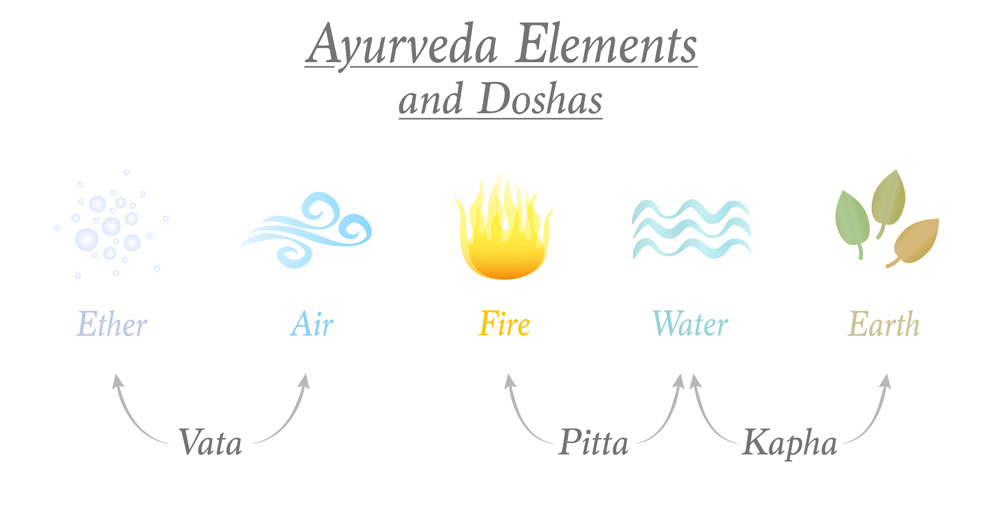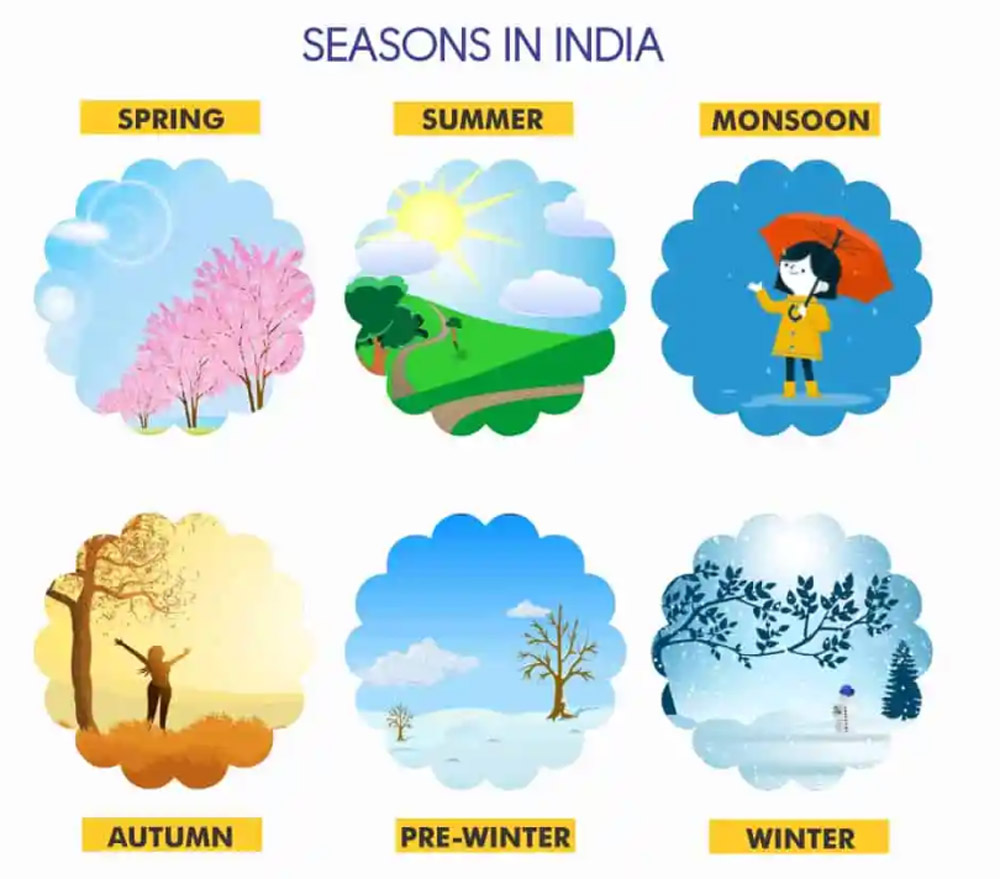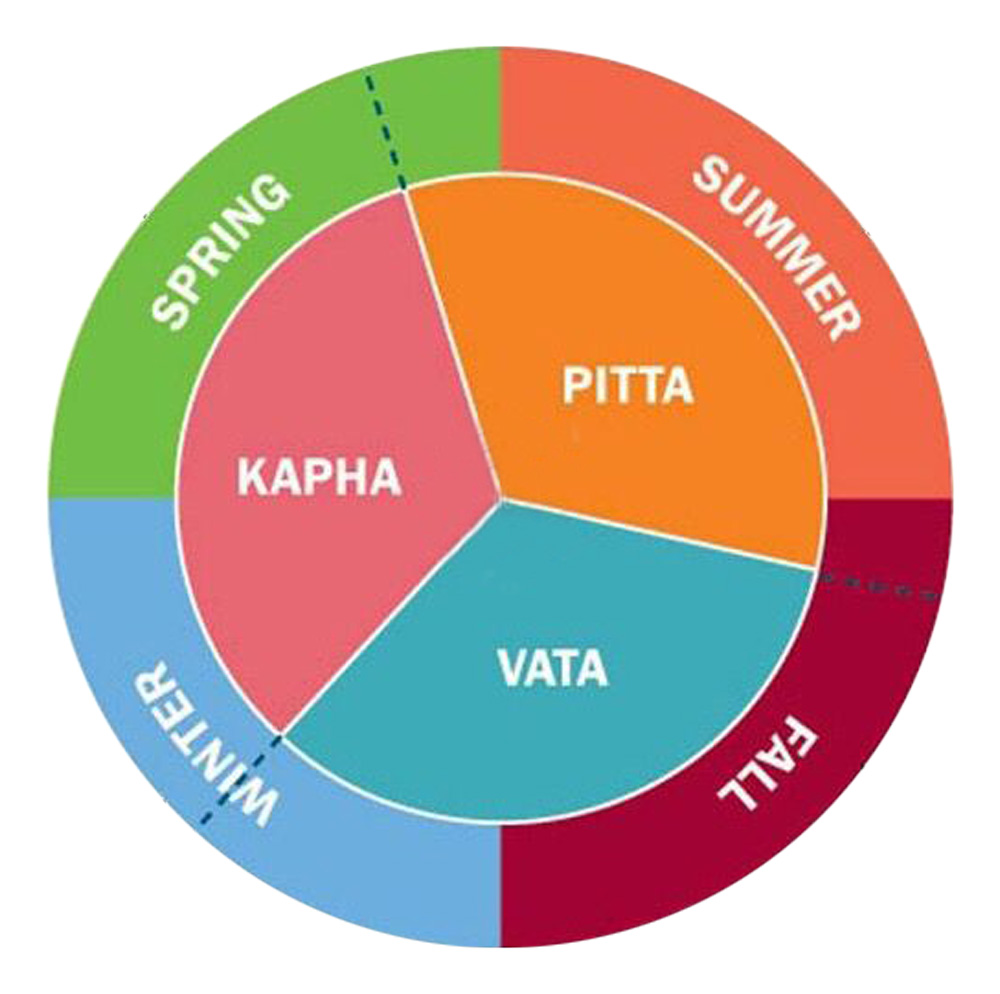Eating with the Seasons
Your Ayurveda guide to healthy eating for your body type
Ayurveda is an ancient energy medicine protocol based on the idea that the universe is composed of five elements — air, fire, water, earth, and ether — and so are humans, and all other life forms and matter, as living progeny of the universe.
The rishis (accomplished and enlightened seers) proclaimed that, as microcosms of nature, all five elements exist in each of us and are represented by three doshas (energies).

VATA (air and ether) is the force that directs nerve impulses, circulation, respiration, and elimination.
PITTA (fire and water) is the force that governs digestive metabolism and organ and tissue systems.
KAPHA (water and earth) is the force responsible for growth and structure (protection and integrity of the being or element).
These three energies are where your body connects with your mind—the place where your thoughts turn into matter that affects how well balanced you are as a being. When any of these three energies go out of whack, Ayurveda offers specific lifestyle and nutritional guidelines to help reduce the turbulence so your body and mind can be restored to balance. In Ayurvedic terminology, a healthy person is defined as “she whose doshas are in balance, appetite is good, all tissues of the body and all natural urges are functioning properly, and mind, body, and spirit are cheerful.”
Your unique mind-body constitution is called prakruti, which means “nature”— your individual nature and body type. It is immensely helpful to learn what your mind-body nature is — which of the three energies are most prominent in your make-up — so you know how to keep them in balance.
TAKE STOCK OF YOUR MIND-BODY BASELINE
By looking closely at your tongue, face, eyes, nails, and lips over a period of time, you can learn which of your energies need to be adjusted. Ayurvedic practitioners can also determine which of your energies are on overload by taking pulses similar to those acupuncturists consult to determine how strong, weak, flat, fast, or shallow these indicators are.

DIET, EXERCISE, DAILY, & SEASONAL ROUTINES DETERMINE LEVELS OF WELLBEING FOR ALL THREE MIND-BODY ENERGY TYPES
If you’re principally Vata, your key to optimal wellbeing is regularity. If you’re experiencing poor digestion, if you catch colds easily, or if you develop insomnia and fatigue, you’re likely experiencing excessive oppositional energies.
If you’re quite Pitta, your key to optimal wellbeing is moderation. When you find yourself flying off the handle or experiencing inflammatory conditions, or if you’re a super-stressed workaholic or overachiever, your energies are out of balance in this area, and need a tune up.
If you’re mostly Kapha, your key to optimal wellbeing is stimulation. When your energies are out of balance, you will most likely experience sinus congestion, poor circulation, and sluggish digestion which can lead to obesity and depression.

Ayurveda outlines a set of seasonal guidelines known as Ritucharya. The guidelines serve as prescriptions for diet and lifestyle changes throughout the year to help keep your mind clear, lift and fulfill your spirit, and help ensure vibrancy within your entire body.
According to Ayurveda, each year is divided into two periods, each covering three seasons:
Uttarayana, the cold months, containing the seasons Sharath, Hemanta, and Shishira
Dakshinayana, the warm months, containing the seasons Vasanta, Grishma, and Varsha.
Why eating for the season is crucial to greater wellbeing
If you’re a nature lover, as I am, you have probably noticed how differently wild ones behave and eat during the four seasons we usually think of: spring, summer, winter, and autumn. Their bodies, like our own, instinctively recognize and respond to seasonal environmental cues and conditions by processing nutrition so their bodies can prepare for the upcoming span of time that lies directly before them.

Meat-eating mammals become voracious as the cold winter months begin to announce their arrival. The bodies of bears, raccoons, wild cats, and wild dogs in their hemispheres begin to fill out as some species ready their bodies for hibernation and other species prepare their bodies for days or weeks of starvation. It’s almost as if Nature/Source has placed a calendar in their craniums that prompts them to consume as much as they can find.
Well, surprise, surprise, surprise (as Gomer Pyle would say)! We humans have the same internal promptings. As the cold months approach, we begin to crave foods that help calm us even as they pack on extra fat, even though you aren’t environmentally bound to seasonal deprivation, as were our ancestors, not long ago, before refrigeration and mass transportation. But our bodies are still designed to operate the way they were back then, so eating in opposition to your promptings can set you up for a compromised immune system, unhealthy weight gain or loss, less healthy and robust skin and hair, and some illnesses. So, eating with the seasons does two things: It makes you feel good and it’s a powerful way to help ensure your wellbeing physically, mentally, and emotionally.
In the West, the Ayurveda practice of Ritucharya is characterized by four seasons, unlike India where there are six. In both countries, though, the energies go through a cycle of accumulating, aggravating, and palliating during the seasons, so our goal is to keep them as balanced as possible by way of lifestyle and diet.

In the U.S. and in Canada, Vata season runs from autumn to early winter, mid-September to January, Kapha season happens from February to May, and Pitta season goes from June to mid-September. But, depending on where you live in the U.S. or Canada, always take your cues from your natural surroundings and fellow creatures. Up against and above the 54th parallel (the border between the US and Canada), the winter season is considerably longer.
Balance your diet by way of opposing energies. What I mean by this is that, during Pitta season, as just one example, the weather is frequently hot, dry, light, and sharp, so counter those with cool, heavy, and bland foods; avoid sour, spicy, salty, and overpowering foods.
DIETARY INSIGHTS AND INFORMATION
Meat
Beef increases Pitta and Kapha but reduces Vata. It is heavy, thick, tastes sweet and its post-digestive effect is sweet. Eating beef heats your body. Beef increases Pitta and Kapha and reduces Vata.
Chicken is moderately okay for all three mind-body types. Sweet and astringent, its post-digestive effect is pungent (stimulating). It is strengthening.
Fish increases Pitta and Kapha but reduces Vata. Eating fish heats your body.
Dairy
Unsalted butter is sweet, astringent and cooling. It promotes intestinal absorption. It increases Kapha and reduces Vata and Pitta.
Unsalted cheese is sweet and sour and cooling. It increases Pitta and Kaphs and decreases Vata.
Cow’s milk is sweet and cooling. It increases Kaph and decreases Vata and Pitta.
Eggs are sweet, astringent and heating. Post digestively, they are pungent. Eggs increase Pitta and Kapha and decrease Vata.
Ghee is sweet and cooling. Taken in excess, it increases Kapha. Taken moderately, it is good for all three energies. It promotes digestion and strengthening.
Goat’s milk is sweet, astringent, and cooling. Post digestively, it is sweet. Increases Vata, decreases Pitta and Kapha. Relieves cough and fever.
As always, consult your health care provider before you undertake any new health regime.

It’s important that your routine, diet included, fits your doshas – the combination of three energy sources that create your unique makeup. When you don’t align with the energy that is unique to you, that is when you feel out of balance. To get started on a deeper exploration of Ayurveda and the wisdom it holds for your health and well-being, take my Dosha quiz to find out which doshas are most prominent in you >>

